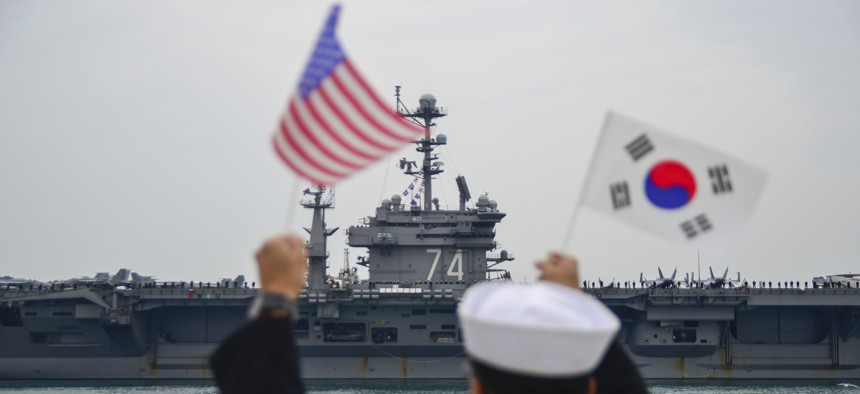
The aircraft carrier USS John C. Stennis (CVN 74) arrives at Commander, Republic of Korea Fleet base in Busan, the new home for the U.S. Navy in Korea. U.S. Navy photo by Mass Communication Specialist 3rd Class Wesley J. Breedlove
Naval Cooperation is More Crucial Than Ever. Here’s What It Costs.
To build key relationships, the US must be willing to trade readiness for presence and exquisite ships for numbers.
Since the 1980s, the tasks that the United States has asked of its Navy have changed radically. Shifts in technology and in the strategic landscape drove much of this change. But these shifts have revealed a confusion about why a navy should exist and what it should prepare to do. Political, bureaucratic, and industrial imperatives have further complicated the effort to sort through the Navy’s purpose. Fundamentally, however, the purpose of the U.S. Navy is to ensure the ability of America, its allies, and its trading partners to enjoy use of the oceans.
The 1990s and early 2000s witnessed a period of ferment in naval doctrinal thinking. The disappearance of the Soviet Navy meant that the U.S. (and its allied navies) had no plausible opponent to prepare for. Building on thinking that had developed in the 1980s, the U.S. Navy took a “littoral turn,” focused on using naval platforms to decisively affect conditions on land.
In the 2000s, this thinking took a turn to the peaceful, with maritime thinkers emphasizing the ability of naval platforms to conduct humanitarian assistance and disaster relief operations. The Indian Ocean tsunami helped catalyze this thinking, as major warships (especially amphibious assault ships) served as centers of relief. The Cooperative Strategy for 21st Century Seapower, growing out of the “1000-Ship Navy” concept, helped crystallize this turn in strategic doctrine. At the time, strategists hoped that this framework could successfully integrate China into a global maritime system, while preserving the pre-eminence of the U.S. Navy in setting “rules of the road.”
Naval Warfare's Future
• With Maritime Superiority at Stake, US Navy Must Build Partnerships
• Five Possible Futures for the US Navy
• Naval Cooperation is More Crucial Than Ever. Here’s What It Costs.
• The Lessons of the Littoral Combat Ship
• To Confront Russia's Subs, NATO Must Team Up on ASW Aircraft
Central to this shift was the acceptance of the sea as a “commons” which enabled the global system of maritime trade, and from which nearly all nations could benefit. The cooperative turn emphasized that navies become useful by enabling humans to take advantage of the sea—to trade, to earn livelihoods from, and to build their cities near. The strategy held out hope that other nations would recognize the value of the commons, while still asserting a central role in the USN for management and regulation.
But the last five years have seen a major turn away from this kind of thinking. The most important reasons for a shift in emphasis have come from the resurgence of tensions with Russia and China. The former has leveraged limited resources to outsized political effect, while the latter has vastly expanded its maritime reach and power. Neither seem to have bought in to the “cooperative” idea of a global flotilla for good.
Alongside this shift came a change in technological priorities. In large part because of the threat posed by Chinese ballistic missiles, missile defense became a critical force-protection priority, pushing such platforms as the DDG-1000 aside. The Marine Corps’ need to provide a platform for the F-35B has curtailed, however modestly, the amphibious capabilities of some of its light carriers. The need to deter, fight, and win a major-power conflict has pushed humanitarian considerations into the background.
Where to Go Now
Everyone agrees that seapower should provide war-fighting dominance alongside cooperative, positive-sum outcomes. People disagree on how to balance these two ends in procurement, training, and basing, and the debate feeds into such questions as the acquisition strategy for the littoral combat ship, or LCS. Granting that the pendulum has shifted in the war-fighting direction, the question has now become “What can be saved of the littoral turn for the future of U.S. naval procurement and practice?” And hopefully, the answer is “a lot.”
The Cooperative Strategy wasn’t just about making friends and saving lives. It was also about forging connections with other navies that the U.S. could leverage in productive ways, both for humanitarian and strategic purposes. Such connections can have a lot of impact on how the navy, and the U.S. government more broadly, approach the construction of an implicit anti-China coalition across the South China Sea.
Thus, even as the strategic and technological situations have shifted (and the best hopes of the Cooperative Strategy delayed, if not dashed), there remains considerable merit in pursuing some of the ends set forth in 2007. But the value comes with costs; a certain degree of tolerance of Chinese naval activity (the PLAN’s presence at RIMPAC, for example), a willingness to trade readiness for presence, and an acknowledgement that having enough platforms to remain on station around the world means accepting limits to the capability of individual ships and planes.
The problems that prompted the Cooperative Strategy remain with us today, and will grow larger in the future. Humans continue to concentrate in the littoral, making them vulnerable to maritime disasters, and particularly susceptible to naval remedies. Notwithstanding the stall in the growth of global trade, sea lanes will continue to require monitoring. If current shipbuilding trends continue, the U.S. Navy will command a steadily dwindling percentage of global hulls, even if each of those hulls enjoys outsized capabilities.
Under these conditions, maintaining a framework for facilitating cooperation is an utter necessity. The United States needs the active support of navies around the world to maintain the international system of trade and management that it established in the wake of World War II. It needs at least the passive acquiescence of the People’s Liberation Army Navy, soon to be the second-largest fleet in the world. Congress, the Department of Defense, and the Navy need to take undoubtedly need to ensure the ability of the USN to defeat the PLAN, or any other competitor. But they also need to keep in mind that navies exist in order to make the sea useful to humankind.
NEXT STORY: The Lessons of the Littoral Combat Ship




